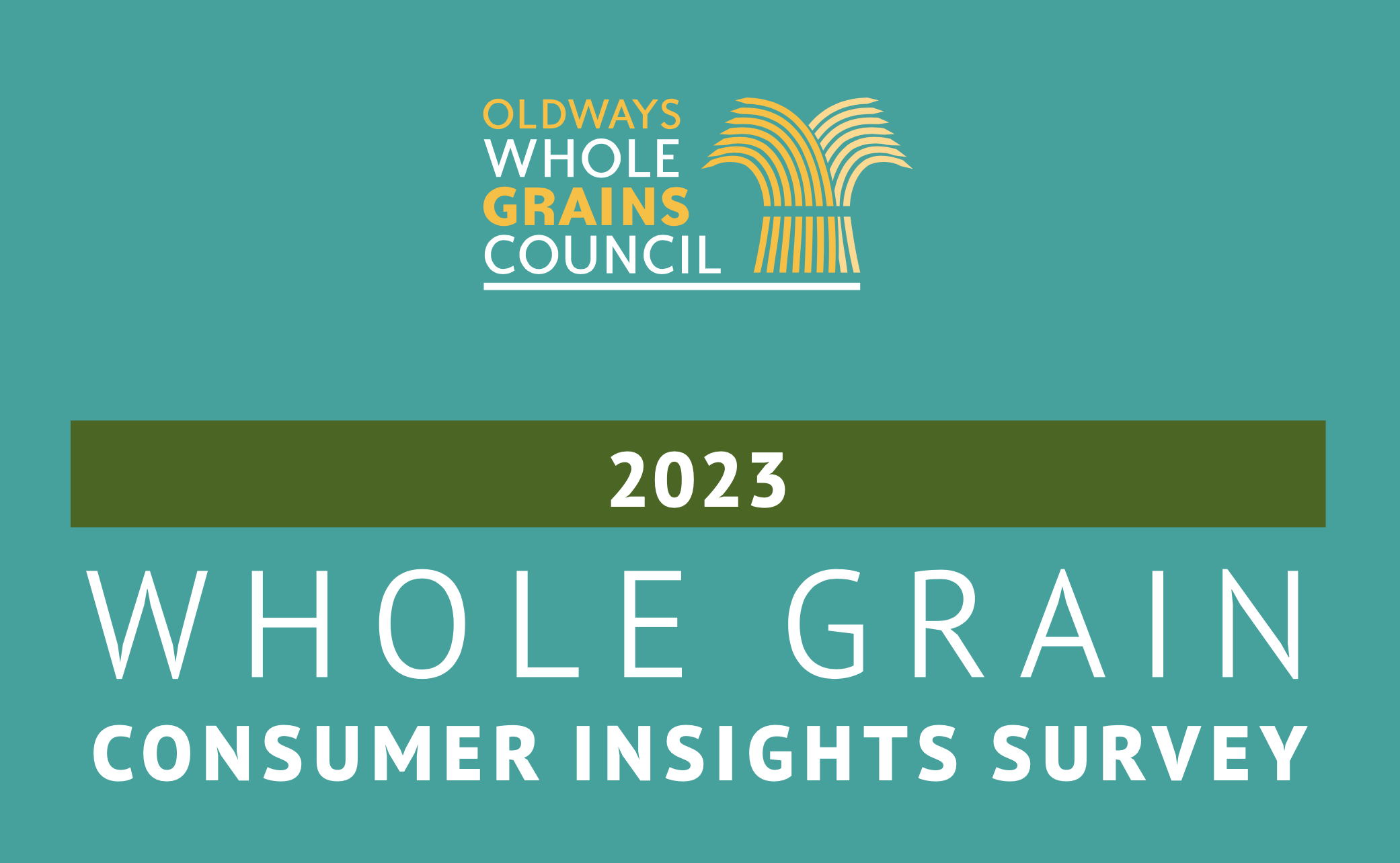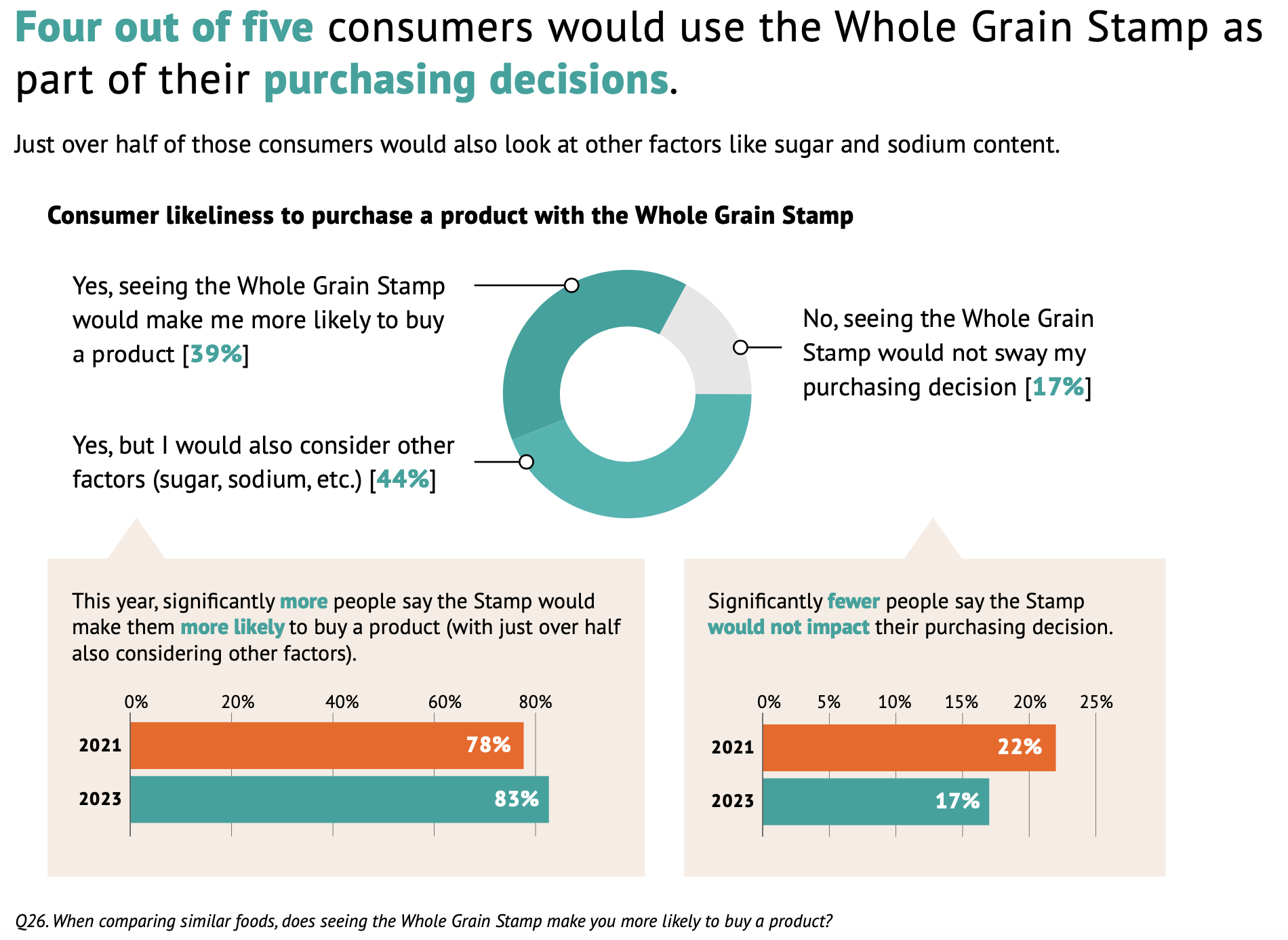Share This
The vast majority of American consumers (77%) say they think they should be choosing whole grains more often, according to our latest survey. Our 2023 Whole Grain Consumer Insights Survey, a census-representative survey of 1500 American adults, found many indicators that consumers are increasingly seeking whole grain foods, not only for their health benefits, but also because consumers see them as tasty and sustainable.
Every few years we comission a survey to ask consumers about their whole grain eating habits and perceptions so that we can understand what people know, find out what barriers exist, and measure the progress we’ve made in pushing that needle in the right direction. The findings this year show clear trends in demand for whole grain products, in the roles that price and sustainability play in purchasing decisions, and in the trust that people place in third-party packaging symbols like the Whole Grain Stamp. Impressively, this survey found that more than 33% of Americans say they have started eating more whole grains in the past five years, and 61% say they now choose whole grains at least half the time, thereby meeting the Dietary Guidelines recommendation to make half your grains whole.
As we take a look at the major themes and takeaways from the survey, four trends stand out:
Trend #1: Consumers see the Whole Grain Stamp as the second-most useful packaging symbol, after the Nutrition Facts Panel.
With whole grain intake on the rise, consumers are increasingly turning to the Whole Grain Stamp as a trusted tool for identifying whole grain products. More than half of respondents say they’ve increased their whole grain intake over the past five years, but the vast majority (77%) also say they think they should be choosing whole grains more often.
Perhaps unsurprisingly, an increasing number of people (79% in 2023, compared with 70% in 2021) told us they wish information about the whole grain content of products was included on product packaging. And with about two-thirds of consumers (64%) say seeing third-party packaging symbols gives them more confidence in the products they are purchasing, symbols like the Whole Grain Stamp are clearly an essential tool to consumers, offering them both whole-grain content information and the piece of mind that comes with third-party certification.
Not only is the Whole Grain Stamp seen as one of the most useful package labels on the market (ranked second in utility after the Nutrition Facts Panel), but 85% of consumers say they trust the Whole Grain Stamp. This year, significantly more people say seeing the Stamp would make them more likely to buy a product (83% in 2023, compared with 78% in 2021), and more consumers say they would question a product’s whole grain claims if they didn’t see the Whole Grain Stamp (58% in 2023, compared with 51% in 2021).
Trend #2: Consumers, Especially Those in Younger Generations, Are Feeling More Sensitive to Food Prices
Inflation has caused food prices to increase at alarming rates over the past few years and consumers are feeling the effects. The percentage of consumers who cited the price of products as a major factor in their purchasing decisions rose this year, from 47% in 2021 to 51% in 2023. The survey also found that younger generations are much more likely to cite cost as a significant barrier to whole grain consumption (37% of Gen Z, 29% of Millennials, 27% of Gen X, 19% of Boomers, 13% of Silent Generation). Efforts to achieve price parity between whole and refined grain products may be more important than ever right now.
Trend #3: Diet Fads That Exclude Grains Are on the Decline
Fad diets that involve low- or no-carb eating patterns or that recommend avoiding gluten without a medical diagnosis appear to be on the decline. The survey found that fewer people say they are avoiding carbs (16% in 2023, compared with 18% in 2021), and among Gen Z and Millennial consumers the numbers are even lower – only 10% of these younger generations are avoiding carbs. Although one quarter of consumers told us they have cut back on gluten somewhat, 94% of people say they eat gluten some or all of the time. This year, significantly more people are not avoiding gluten at all compared to two years ago (70% in 2023, compared with 66% in 2021).
Trend #4: Millennials Lead the Way When It Comes to Shopping with Sustainability in Mind
Millennials are significantly more focused on the sustainability benefits of whole grains compared to other generations, with 24% of this group saying they choose whole grains for that reason (compared with 14% among Gen Z, Gen X, Boomers, and the Silent Generation). Millennials are more likely to choose foods that are environmentally sustainable and good for the climate (27%, compared with 23% of all consumers), and they are more likely to buy organic food (32%, compared with 23% of all consumers). Three-quarters of Millennials (72%) say they think of whole grains when they think of foods that are sustainable and environmentally friendly.
Review our full 2023 Whole Grain Consumer Insights Survey and let us know in the comments below which statistics stood out most to you. (Caroline)
To have our Oldways Whole Grains Council blog posts (and more whole grain bonus content!) delivered to your inbox, sign up for our monthly email newsletter, called Just Ask for Whole Grains.



Comments
Add a Comment